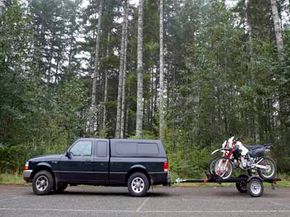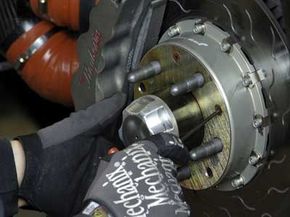
A trailer can't go too far without its wheels. In theory, you could hitch a wheel-free platform to the back of a truck and drag it along behind you, but you probably wouldn't risk anything valuable like a boat on top of it. Fortunately, trailers come equipped with a set of wheels, so they roll along with our vehicles like oversized cargo holds.
Trailer wheel hubs play an integral role in keeping trailers rolling along. The trailer wheel hub assembly connects the trailer tires to the trailer axle and facilitates their spin. If those wheel hubs corrode or aren't installed properly, it will throw the trailer tires out of alignment and could lead to serious damage of your vehicle, trailer and whatever you're toting around. If, for instance, you're towing your dinghy to the lake for a weekend getaway, that fist-sized collection of hardware in a wheel hub can make the difference between relaxing on the water and spending hours making repairs.
Advertisem*nt
Because the wheel hubs influence the overall performance of your trailer, routine maintenance is imperative. Depending on the size of your trailer wheels and the frequency of use, you should remove and, if necessary, replace parts in the trailer hub assembly at least once per year. Some towing experts recommend doing so every 10,000 miles (16,093 kilometers). For trailers with smaller wheels that must rotate more often, it may be wise to check the hubs as much as every 2,000 miles (3,218 kilometers) [source: Siuru].
Fiddling with your trailer wheel hubs may sound like a tall order, but a little learning can go a long way to extend the life of your towing trailer. First up, we'll take apart the trailer wheel hub assembly to understand exactly what parts we're working with.
Advertisem*nt
Contents
- Purpose of Trailer Wheel Hubs
- Installing Trailer Wheel Hubs
- Trailer Wheel Hub Kits
Purpose of Trailer Wheel Hubs

The purpose of the wheel hub is to serve as the glue between the tire and the axle. Tires are attached with studs to the hub assembly. The hub assembly then fits on the axle, which connects the tire component to the rest of the car. Because the wheel hub is the bridge between the tire and the entire vehicle, if one of its parts breaks down, it creates a ripple effect. That could include problems such as impaired steering or a broken axle.
What's going on inside of that wheel hub assembly? A hub isn't a standalone piece of hardware. Instead, it needs a handful of other parts to do its job. The trailer wheel hub looks sort of like a metal donut that slides onto the axle. On either side of the hub, you have the inner and outer bearings. (You can learn more about wheel bearings in How Trailer Bearings Work.) In brief, the bearings are cylindrical pieces that are packed with grease that reduce friction during tire spin. A castle nut at the center of the hub assembly holds the hub and the bearings in place on the axle. A sticklike piece of metal called a cotter pin then secures the castle nut.
Advertisem*nt
The bearings in the hub must stay adequately greased to reduce the heat by-product as much as possible. Also, dirt and water that contaminate the hub can impede tire rotation. For that reason, a grease cap, which is sometimes referred to as a dust cap, fits over the outside of the trailer wheel hub to keep the grease in and the impurities out.
So with all of these parts, how do you go about removing or replacing a trailer wheel hub? We'll discuss installation on the next page.
Advertisem*nt
Installing Trailer Wheel Hubs

Removing or replacing trailer wheel hubs is something that you can do without having to pay the mechanic. It shouldn't take much manpower to assemble or disassemble, although, you'll want to keep track of all the parts you're handling. A standard toolbox with a hammer, pliers and wrench should sufficiently arm you for the task. You'll also want bearing grease on hand and, if you're performing regular maintenance on a hub assembly, a solvent to dissolve old grease on the bearings.
When you're purchasing a trailer hub assembly, there's some valuable information to know in order to make the correct selection. Wheel hubs aren't one-size-fits-all parts. They vary in dimensions based on the size of the trailer wheels and the bearing load. Before you buy, you should:
Advertisem*nt
- Find out how many stud holes should be in the hub. Hub assemblies usually come with either four or five holes around the circumference. Those slots are for studs that join the tire hub cap to the wheel hub.
- Measure the diameter of bolt hole in the center of the hub. That is where you screw in the castle nut to hold everything in place. Most wheel hubs have bolt hole diameters between 4 and 6 inches (10 and 15 centimeters), divided into half-inch increments. To obtain that figure, measure from the center of that large bolt hole to the center of a stud hole, and divide that number by two [source: Eastern Marine].
- Know the inner and outer bearing size. You won't have to pull out your ruler for this one since most bearing have a reference number engraved on them that signify their diameter. The dealer you buy the hub from should have that chart available, or you can find it online.
Once you have your wheel hub assembly with the correct specifications, it's time to install. There are a couple of tips for hub installation to prevent later problems with your tires. First, spread a thin coating of the bearing grease on the inside of the hub before you slide it onto the axle. You don't want a lot on there -- just enough to help it slip on easily. Also, when you tighten the assembly in place, don't overdo it. If you adjust your castle nut correctly, the hub shouldn't move more than a .25 inches (.6 centimeters) after the tire is attached [source: e-trailer].
Up next, we'll learn about trailer wheel hub kits that contain entire hub assemblies. If you're installing a new hub, these kits can simplify the process.
Advertisem*nt
Trailer Wheel Hub Kits

Instead of having to purchase the many parts of a trailer wheel hub individually, manufacturers offer them as kits. Many such kits come with bearings, seals, a grease cap, a cotter key and nuts and bolts. Some offer the option of having the bearings preassembled and already greased as well.
Just because a hub assembly comes pre-greased, that doesn't mean it's greased for life. You should still check it regularly for corrosion, cracking or other damage at least once a year. Bearing Buddies can make that maintenance process simpler. A Bearing Buddy is essentially the same thing as a grease cap, except that it has an opening for a grease gun that allows you to inject new grease into the bearings without having to pack it by hand. Unless you have a wheel hub assembly with this type of cap and a system for expelling the old grease without removing the bearing from the hub, you must still take the hub off the axle and clean it out.
Advertisem*nt
If you're in the market for a trailer wheel hub assembly kit, you'll also need the same information mentioned on the previous page to know the right one to buy for the size of your trailer wheels. Whole kits aren't necessary to install your trailer wheel hub, especially if you just have a problematic bearing or grease seal, which are the most commonly replaced parts in the hub assembly. You can buy those parts, or any other in the trailer wheel hub assembly, separately.
Now that you have your wheel hubs locked and loaded and tires securely in place, it's time to tow. Roll on to the next page for more information on towing and auto topics.
Advertisem*nt
Lots More Information
Related HowStuffWorks Articles
- How Grease Caps Work
- How to Use Mirrors While Towing
- 10 Tips for Easy Towing
- How to Turn While Towing
- How to Brake While Towing
- How to Shift While Towing
- How to Pass While Towing
- How Boat Towing Safety Works
- How Trailer Towing Safety Works
- Is there a green way to tow?
More Great Links
Sources
- "Bearing Service." The RVers' Corner. (Oct. 16, 2008) http://www.rverscorner.com/articles/bearing1.html
- "Replacing the Bearings, Races and Seals on a Trailer Hub." e-trailer. (Oct. 16, 2008) http://www.etrailer.com/faq_wheelbearingpack.aspx
- Siuru, William D. "Keeping Trailer Wheel Bearings Going Round and Round." New Car Buying Guide. (Oct. 16, 2008) http://newcarbuyingguide.com/index.php/news/main/4363/event=view
- "SuperLube Wheel Hub/Spindles Owners Manual." Tie Down Engineering. 2004. (Oct. 16, 2008) http://www.tiedown.com/pdf/c718.pdf
- "Wheel Hubs: Technical Information." Eastern Marine. (Oct. 16, 2008) http://www.easternmarine.com/em_store/tech_info/wheelhub_tech_info.html